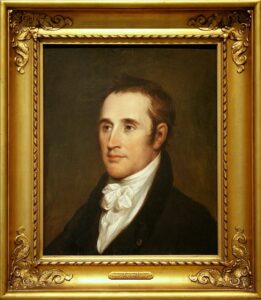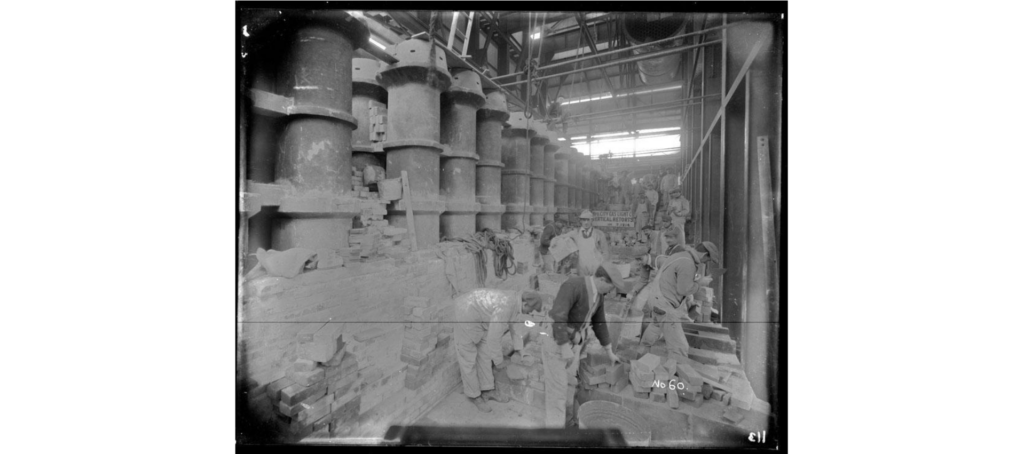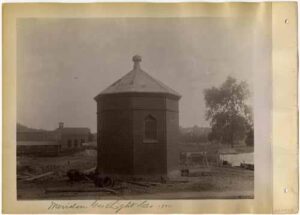By Edward T. Howe
The first private gas light companies in Connecticut appeared just before 1850 in New Haven, Hartford, and Bridgeport. To light streets, businesses, and homes, the companies replaced candles and whale oil with manufactured gas. By the late 19th century, they began offering gas for heating and cooking. For Connecticut, manufactured gas provided a new way of lighting the state and powering its future.
Growth of Manufactured Gas

John Trumbull painting of Benjamin Silliman, who organized New Haven’s first manufactured gas company – Wikimedia Commons, cliff1066
Before companies organized to provide gas light to customers, individuals in the United States experimented on their own. Michael Amboise became one of the first to use manufactured coal gas when he illuminated an amphitheater in Philadelphia, Pennsylvania in 1796. Ten years later, David Melville of Newport, Rhode Island, became the first person in the United States to light his street and home by burning coal and wood to produce hydrogenous gas.
By 1812, Frederick Winsor in England received a parliamentary charter for the world’s first gaslight company, “The London and Westminster Chartered Gaslight and Coke Company.” Sustainable gas distribution on a commercial scale finally became a reality in the United States when “The Gas-Light Company of Baltimore” received authorization for a municipal franchise in 1816 (a private company chartered in 1817 by the state legislature). The franchise—a template for future authorizations—allowed the company to lay pipes under the city streets to convey manufactured gas from any authorized manufactory for street lighting. Other cities quickly chartered gas distribution facilities including Boston and New York City in 1823, Brooklyn in 1825, St. Louis in 1839, and Albany in 1845.
Gas Distribution in Connecticut
The first gas distribution company in Connecticut, the New Haven City Gas Light Company, received a state charter in 1847, after Yale professor Benjamin Silliman and several businessmen organized the firm. Gas first lit streetlamps in 1848 and by the early 1850s, the company managed to power 189 streetlights and 1,252 homes and businesses. It became the New Haven Gas Light Company in 1854.
Two other Connecticut cities quickly followed suit. In 1848, The Hartford City Gaslight Company received a charter from the state capital. (Initially, Hartford only had a few streetlights in operation, centered around the state capitol, before slowly expanding further.) Within a year, The Bridgeport Gas Light Company organized. Two years later, the company lit 76 home and business customers along with 26 public streetlamps.
All three private companies acquired municipal franchises that gave them the sole right to construct their network facilities in a given area and to manufacture gas from coal. The coal gas was transmitted to a gas holder for distribution to customers though six-inch diameter pipes. The original price of the gas was expensive, about four dollars for a thousand feet. Customers complained about the high price of the gas, its smell, and service availability. Nonetheless, the arrival of these firms signaled a proliferation of manufactured gas firms throughout the state.
The Decline of Manufactured Gas
Manufactured gas remained the major source for lighting throughout most of the 19th century. By the end of the century, however, these three companies also began offering gas for home water heating and industrial use. After 1890, the companies especially turned to providing gas for cooking to counter the loss of customers switching to the emerging electric utility companies. By the mid-1950s, interstate natural gas pipelines provided a product that was cleaner, cheaper, and had a higher energy content than manufactured gas. Thus, manufactured gas plants became obsolete and less popular.
In 1967, the New Haven and Bridgeport gas companies merged to form the Southern Connecticut Gas Company. The Hartford gas company became the Connecticut Natural Gas Corporation in 1970. Both companies, along with Berkshire Gas of Massachusetts, became subsidiaries of Iberdrola, a Spanish utility company, in 2010.
Edward T. Howe, Ph.D., is Professor of Economics, Emeritus, at Siena College near Albany, N.Y.










